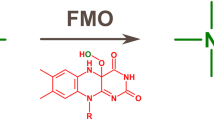Abstract
The toxicity of most xenobiotics is associated with their enzymatic conversion to toxic metabolites, a process termed bioactivation. Although stable, but toxic, metabolites may be formed, as in the biotransformation of dichloromethane to carbon monoxide, most bioactivation reactions afford electrophilic, reactive intermediates. The reactivity of these intermediates usually prevents their direct observation and characterization. Hence strategies that permit the experimentalist to gain insight into the formation and fate of reactive intermediates is of much value in understanding bioactivation reactions. The objective of this review is to point out the utility of computational chemistry in studying the formation and fate of toxic metabolites.
Access this chapter
Tax calculation will be finalised at checkout
Purchases are for personal use only
Preview
Unable to display preview. Download preview PDF.
Similar content being viewed by others
References
Bowen, J. P., Charifson, P. S., Fox, P. C., Kontoyianni, M., Miller, A. B. Schnur, D., Stewart, E. L., Van Dyke, C., 1993, Computer-assisted molecular modeling: Indispensable tools for molecular pharmacology, J. Clin. Pharmacol, 33, 1149–1164.
Andrianov, A. M., and Akhrem, A. A., 1993, Model of the spatial structure of peptide T, Molekuliarnai Biologiia 27, 934–946.
Goddard III, W. A., 1985, Theoretical chemistry comes alive: Full partner with experiment, Science 227, 917–923.
Schaefer III, H. F., 1986, Methylene: A paradigm for computational quantum chemistry, Science 231, 1100–1107.
Anders, M. W., 1991, Metabolism and toxicity of hydrochlorofluorocarbons: Current knowledge and needs for the future, Environ. Health Perspect. 96, 185–191.
Korzekwa, K. R., Jones, J. P., and Gillette, J. R., 1990, Theoretical studies on cytochrome P-450 mediated hydroxylation: A predictive model for hydrogen atom abstractions, J. Am. Chem. Soc. 112, 7042–7046.
Olson, M. J., Kim, S. G., Reidy, C. A., Johnson, J. T., and Novak, R. F., 1991, Oxidation of 1,1,1,2-tetrafluoroethane (R-134a) in rat liver microsomes is catalyzed primarily by cytochrome P450IIE1, Drug Metab. Dispos. 19, 298–303.
Herbst, J., Köster, U., Kerssebaum, R., and Dekant, W., 1994, Role of P4502E1 in the metabolism of l,1,2,2-tetrafluoro-l-(2,2,2-trifluoroethoxy)-ethane, Xenobiotica 24, 507–516.
O’Hagan, D., and Rzepa, H. S., 1994, Stereospecific control of the citrate synthase mediated synthesis of (2R,3R)-3-fluorocitrate by the relative stabilities of the intermediate fluorocnolates, J. Chem. Soc, Chem. Commun. 1994, 2029–2030.
Martin, D. P., Bibart, R. T., and Drueckhammer, D. G., 1994, Synthesis of novel analogs of acetyl coenzyme A: Mimics of enzyme reaction intermediates. J. Am. Chem. Soc. 116, 4660–4668.
Tsai, R.-S., Carrupt, P.-A., Testa, B., and Caldwell, J., 1994, Structure-genotoxicity relationships of allylbenzenes and propenylbenzenes: A quantum chemical study, Chem. Res. Toxicol. 7, 73–76.
Hartung, R., 1982, Cyanide and nitriles, In Patty’s Industrial Hygiene and Toxicology (Patty, F. A., Clayton, G. D., and Clayton, F. E., Eds.) pp. 4845–4900, Interscience, New York.
Grogan, J., DeVito, S. C, Pearlman, R. S., and Korzekwa, K. R., 1992, Modeling cyanide release from nitriles: Prediction of cytochrome P450 mediated acute nitrile toxicity, Chem. Res. Toxicol. 5, 548–552.
Author information
Authors and Affiliations
Editor information
Editors and Affiliations
Rights and permissions
Copyright information
© 1996 Springer Science+Business Media New York
About this chapter
Cite this chapter
Anders, M.W., Yin, H., Jones, J.P. (1996). Application of Computational Chemistry in the Study of Biologically Reactive Intermediates. In: Snyder, R., et al. Biological Reactive Intermediates V. Advances in Experimental Medicine and Biology, vol 387. Springer, Boston, MA. https://doi.org/10.1007/978-1-4757-9480-9_42
Download citation
DOI: https://doi.org/10.1007/978-1-4757-9480-9_42
Publisher Name: Springer, Boston, MA
Print ISBN: 978-1-4757-9482-3
Online ISBN: 978-1-4757-9480-9
eBook Packages: Springer Book Archive




